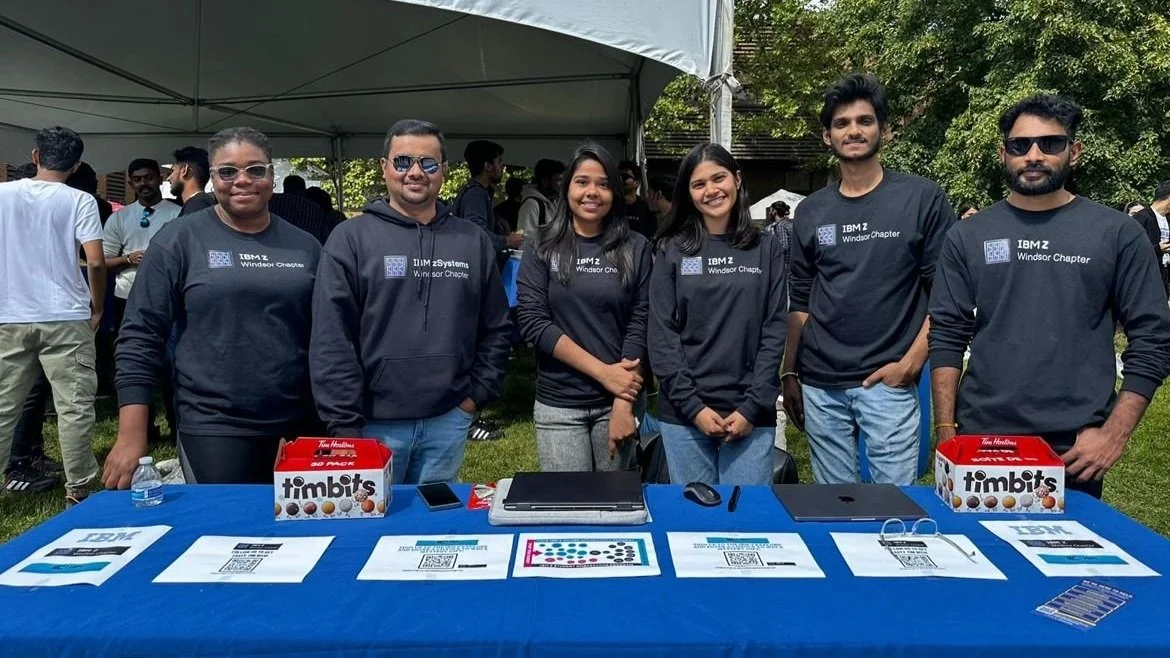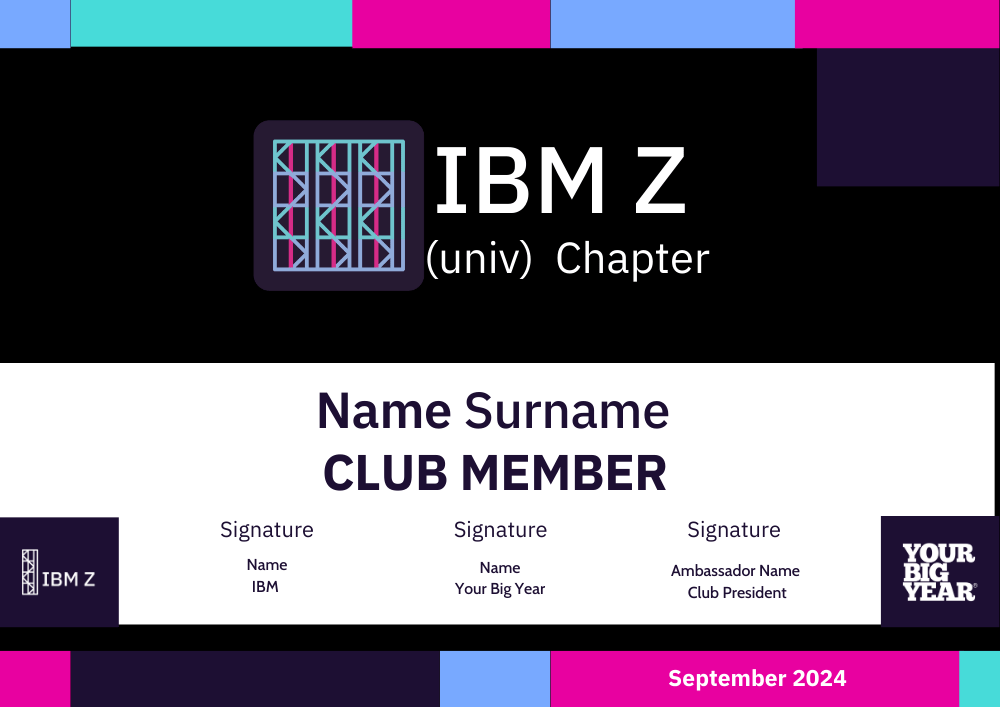Start a Club or Community
Isn’t it more fun when you get others involved? We think so which is why the best focus of your time is to set up a club for your campus. A ‘club’ can be:
Campus club - online or in-person
Chapter
Community
Society
Membership Organization
Group
Partnership with an existing campus club
Every College has a different process. While we will provide information to help you, there isn't a one-size-fits-all formula. With a little research, you can establish a club on your campus that best fits your school and student network!
Keep us posted on your progress!
The Your Big Year team is here to help. Let us know right away if you are thinking about or have started a club by texting us or submitting a quick update:
Let’s Start!
We’ve set up resources to help you get started:
2. #ClubFacilitators Channel: Ambassador Hub > Collaboration Forum > #ClubFacilitators
3. Resource written by fellow IBM Z Student Ambassador Alumni
7 Steps for Starting a Club
by Devonte’ Hawkins
IBM Z Employee and IBM Z Student Ambassador alumni
-
The first step to take when making your own club is to gather the founding members, clarify the purpose of your club and identify any long-term goals you want to achieve. Questions for founders to ask to identify a club’s purpose:
Why are we forming a club?
What is our social club’s mission statement?
What are our club’s long-term goals?
Many Colleges require Code of Conduct & Constitution. Here is a sample from your peer. Click here to access.
-
Any club will need leadership or a governing structure. The type of organization will determine whether the structure should be formal or relaxed. In other words, will you operate through an elected Board of Directors or create a less formal club management arrangement?
Here are some of the key leadership roles to consider:
President: This role is a key representative who can lead the club and act as a spokesperson.
Vice President: This role is a supportive role that offers a back-up for the Leader. Example titles: Vice-President, Vice-Chair, etc.
Treasurer: This role is responsible for keeping track of club money, fees, expenses, paying bills, taxes, etc.
Communications Manager or Secretary: This role is responsible for internal communications: meeting minutes, drafting objectives, keeping track of goals for activities, dates for gatherings, sending out meeting reminders and invitations, etc.
Membership Officer: This role is responsible for maintaining member records and developing member recruitment strategies.
Advisor: A faculty member at the institution to advise the club.
-
Now that you and your fellow founding members have a shared understanding of the club’s mission and objectives, it’s time to start growing your membership. But before you can grow your membership, you need to understand what people to target for recruitment.
Questions to help founders identify potential club members:
What criteria do new members need to have?
Are there any restrictions to new membership?
Are there ideal demographics or psychographics for new members?
-
Some colleges offer financial support for established clubs. If this is not offered decide if you will have expenses. Perhaps you want to provide food or stickers or swag? If so, then you will need to think about fundraising activities.
Regardless, developing and maintaining effective financial records is the key to success for any club or organization. As your membership grows, financial record-keeping will become increasingly important. Get your financial records off on the right foot with these quick tips:
Identify any and all sources of income (membership fees, fundraisers, donations)
Itemize all potential club expenses related to existing meetings or events as well as plans for the next year (meeting room costs, food, equipment, bank fees, promotional costs, member service costs)
Develop a draft budget*
Draft financial policies for the club (member fees, meeting fees, sponsorship levels)
Have your leadership team review and finalize the budget and financial processes together.
-
A website/social media is key to presenting your club to the public — including many prospective members and the media. The key to an effective website is creating and publishing high quality content on a regular basis. A great club website outlines the benefits of membership and includes a membership application form for potential members to apply, connect, and ask questions.
A great place to start is by creating your Club banner. Here is artwork for you to customize.
-
Once your club website is ready to go and you’ve started recruitment, it’s time to host your first meeting!
Although this may seem intimidating, don’t worry: all your new members are just as nervous as you.
We’d also recommend not trying to do too much in the first meeting. It’s best to keep it simple, and follow a structure such as:
Introducing the club and its mission
Introducing founding members
Describing general meeting structure
Asking members why they joined and what they’re hoping to get from the club
Opening nominations for open positions such as secretary and treasurer
Don’t forget to provide some time to mingle — the faster new members get to know each other, the easier it’ll be to keep them coming back to your next meetings.
At the end, you should also let members know what they can expect from the club going forward. For example, will you hold weekly meetings, or limit it to once a month? Will the meeting location change? Setting out clear expectations will ensure member
-
Here are a few ideas we’ve seen successful clubs use in order to keep their members happy and numbers growing.
1. The Easiest Way to Keep in Touch
Want to make sure all your members know when they can come to meetings? An online newsletter is a cost-effective way to:
keep members informed
promote your organization to external audiences
drive traffic to your website
However, it’s worth checking in with your members to see what kind of content they’d like to see from it.
2. Keep the Discussion Going
3. Stay Social
4. Check in With Your Members
Current IBM Z Clubs:
CLUB MEMBERS INFORMATION
Benefits of Being an IBM Z Club Member
Note: Below attached are some ideas for potential activities and events you can promote to your club members. Please keep in mind that these suggestions should be tailored to suit the specific interests of your club. Some ambassador-only activities, such as Leadership Sessions or select IBM events, may not be open to club members, so we encourage you to adjust your communications accordingly to avoid any misunderstandings.
IBM Z Campus Club Members Sample Certificate
-
Upon joining, members receive a certificate recognising their affiliation with the IBM Z Club, showcasing their commitment to mainframe computing.
Note: Kindly submit a list of names of the club members and send it to us at ibmz@yourbigyear.com
-
Stay updated on upcoming career opportunities in the mainframe sector.
Access to IBM’s virtual events tailored for professional growth.
-
Stay updated on upcoming career opportunities in the mainframe sector.
Access to IBM’s virtual events tailored for professional growth.
-
Participate in workshops, hackathons, and challenges to enhance your skills using IBM platforms.
Ongoing support for completing IBM technical training courses and earning valuable badges and certifications.
-
Join a supportive network where members can collaborate, share knowledge, and assist each other with technical challenges.
Opportunities for casual meet-ups and social events to foster camaraderie within the IBM Z community.
-
Engage in initiatives that promote awareness of future careers in mainframe technology.
-
Gain access to Z Xplore and other IBM platforms, providing valuable materials for learning and skill enhancement.
Regular updates and engagement through social media to keep members informed and connected.













